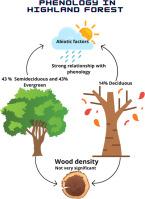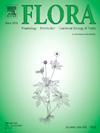Do stem functional traits determine the phenology of tree species in semiarid highland forest, Brazil?
IF 1.8
4区 生物学
Q3 ECOLOGY
引用次数: 0
Abstract
The phenology of tree species in tropical forests is better understood when both environmental factors and functional traits of plants are analyzed. However, the relation between phenology and functional traits is still poorly explored, especially in forest ecosystems. This study analyzed the relation between phenology, wood density (WD) and wood water storage capacity (Qwsat) of 21 tree species from highland forest, montane wetland in the semiarid region of Brazil, as well as their relation with environmental factors. Most species are semideciduous (43 %) or evergreen (43 %), while only three (14 %) are deciduous. Many species (86 %) have shown WD between 0.52 and 0.62 g/cm³, with low Qwsat, while only three species (14 %) have presented lower wood density (0.38–0.48 g/cm³), with higher Qwsat in their stems (105–157 % of dry mass). Leaf budding was positively influenced by rainfall. Leaf fall was the phenophase affected by the greatest number of variables, showing negative relationships with both humidity and wood density. Additionally, evergreen species exhibited a 22.4 % lower leaf fall rate compared to the other groups. These results indicate that stem functional traits were not relevant to explain the phenology of plant species in this environment, but that budding and leaf fall have a great contribution to understanding the functioning and distribution of functional groups in an upland forests. These results reveal that, unlike the surrounding Caatinga vegetation, in the highland forest the stem functional traits were not good indicators of plant functioning, but leaf traits are of great relevance.

茎功能性状是否决定了巴西半干旱高原森林树种的物候?
对热带森林树种物候特征进行综合分析,可以更好地了解热带森林树种的环境因子和功能性状。然而,物候与功能性状之间的关系,特别是在森林生态系统中,还没有得到充分的探讨。本研究分析了巴西半干旱区山地湿地高原森林21种树种物候、木材密度和木材储水量的关系及其与环境因子的关系。大多数种类是半落叶(43%)或常绿(43%),只有3种(14%)是落叶。许多树种(86%)的WD值在0.52 ~ 0.62 g/cm³之间,Qwsat值较低,而只有3种树种(14%)的木材密度较低(0.38 ~ 0.48 g/cm³),树干的Qwsat值较高(占干质量的105 ~ 157%)。叶片出芽受降雨的正向影响。落叶是受变量影响最多的物候期,与湿度和木材密度呈负相关。此外,常绿树种的落叶率比其他类群低22.4%。这些结果表明,茎部功能性状与该环境下植物物候特征的解释并不相关,但出芽和落叶对了解高原森林功能群的功能和分布有重要贡献。这些结果表明,与周围植被不同,高原森林的茎功能性状不是植物功能的良好指标,而叶片性状具有重要的相关性。
本文章由计算机程序翻译,如有差异,请以英文原文为准。
求助全文
约1分钟内获得全文
求助全文
来源期刊

Flora
生物-植物科学
CiteScore
3.30
自引率
10.50%
发文量
130
审稿时长
54 days
期刊介绍:
FLORA publishes original contributions and review articles on plant structure (morphology and anatomy), plant distribution (incl. phylogeography) and plant functional ecology (ecophysiology, population ecology and population genetics, organismic interactions, community ecology, ecosystem ecology). Manuscripts (both original and review articles) on a single topic can be compiled in Special Issues, for which suggestions are welcome.
FLORA, the scientific botanical journal with the longest uninterrupted publication sequence (since 1818), considers manuscripts in the above areas which appeal a broad scientific and international readership. Manuscripts focused on floristics and vegetation science will only be considered if they exceed the pure descriptive approach and have relevance for interpreting plant morphology, distribution or ecology. Manuscripts whose content is restricted to purely systematic and nomenclature matters, to geobotanical aspects of only local interest, to pure applications in agri-, horti- or silviculture and pharmacology, and experimental studies dealing exclusively with investigations at the cellular and subcellular level will not be accepted. Manuscripts dealing with comparative and evolutionary aspects of morphology, anatomy and development are welcome.
 求助内容:
求助内容: 应助结果提醒方式:
应助结果提醒方式:


